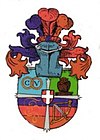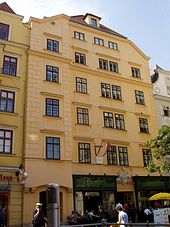KAV Bajuvaria Vienna
|
KAV Bajuvaria |
|
|---|---|
| coat of arms | Circle |

|

|
| Basic data | |
| University / s: | University of Vienna |
| Founding: | June 19, 1920 in Vienna |
| Place of foundation: | Vienna |
| Corporation association : | Austrian Cartel Association , 1932 |
| Colours: | dark blue-red-gold |
| Type of Confederation: | Men's association |
| Position to the scale : | not striking |
| Motto: | "For people and faith" |
| Website: | www.bajuvaria.at |
The Catholic Academic Association Bajuvaria (KaV Bajuvaria) in the ÖCV is a colored , non-striking , Viennese student association that belongs to the largest association of academics in Austria, the Austrian Cartel Association (ÖCV). Bajuvaria was last chairman of the ÖCV (suburb) in the 2017/18 academic year. Bajuvaria has provided the suburb of the ÖCV four times.
history
In November 1919, a group of middle school students from the Staatsgymnasium in Vienna's 3rd district founded the Catholic Middle School Association Frankonia in the parish of St. Rochus. Since there were already Matura candidates among the members at that time, the intention was to later also accept students in this connection. However, this form of a student union for middle school and college students was not permitted under association law. Thus, on June 19, 1920, the boys' convention of Frankonia decided to found the Catholic academic association Bajuvaria. As early as 1923, Bajuvaria had enforced the difficult to obtain right to appear in colors at the university.
In 1932 the connection followed in the CV. The pressure of the National Socialists on the Austrian CV connections led to their separation from the CV in 1933 and the establishment of the Austrian Cartel Association (ÖCV) . The corporations of the ÖCV excluded National Socialists from their ranks and Bajuvaren were also active in leading positions in the struggle for an independent Austria. Above all, one of the founders, Eduard Chaloupka , should be mentioned here, who had worked in the Federal Commissioner for Personnel Affairs since March 1934, at a position which u. a. should reprimand illegal National Socialists in the civil service. Immediately after Hitler's invasion, the Bajuvaria was banned, some members lost their jobs, were taken into custody or even taken to concentration camps. Numerous Bajuvars kept in contact with one another during the Nazi era and were involved in resistance groups.
In autumn 1945 an improvised liaison operation could be resumed. A highlight for the commitment to a free Austria was the foundation party on the eve of the signing of the State Treaty. On May 14, 1955, Bajuvaria awarded Chancellor Julius Raab her ribbon of honor, in the presence of Foreign Minister Leopold Figl, who had already received the ribbon in 1947, and the apostolic nuncio Archbishop Giovanni Dellepiane .
In July 2016 Bajuvaria officially announced her candidacy for the suburb of the ÖCV and was unanimously elected in January 2017. This was the fourth time that Bajuvaria held this office after 1968/69, 1972/73 and 1996/97. The local president for the 2017/18 academic year was Michael Jayasekara. Jayasekara followed in the footsteps of Claus Raidl , who was elected suburb president of the ÖCV for the first time in 1968 for the Bajuvaria. During the 2017/18 term of office, the public awareness of the ÖCV in particular increased.
Connecting life
The KAV Bajuvaria is divided into a student association (the Aktivitas) and an old men association. With around 50 active members and 350 old men, it has around 400 members, making it one of the larger connections in Vienna. Its members come from various disciplines at the University of Vienna, the University of Natural Resources and Life Sciences, the Medical University of Vienna, the University of Economics and others.
Since its inception, the Bajuvaria has cultivated traditional student customs and lives according to the four principles (Religio, Patria, Scientia, Amicitia) that are common to all connections in the ÖCV.
Bajuvaria has a ribbon and cover (color) as a color-bearing connection. The colors are dark blue-red-gold. The motto is "For people and faith".
Booth history
Since the 1950s, Bajuvaria has developed from a small country road connection to a large connection that not only required a new connection home, but also a communication center that was easily accessible to all members. In 1958 the connection moved to the 1st district, to Walfischgasse 4. These rooms also included the Kärntnertor-Theater (today's StadtTheater walfischgasse ), the rooms of which were repeatedly rented to various ensembles. In 1969, this was even discussed in the debate on the federal accounts of the 129th session of the National Council. The topic was leasing the Kärntnertor Theater to the federal government. The ÖVP government was accused by the opposition of supporting the Bajuvaria with this lease. The restaurant in Walfischgasse could no longer meet the needs of a student union.
In 1980, with the aim of creating a new home on two floors for the Bajuvaria, the upper floors of the vacant and dilapidated house in Vienna 1., Naglergasse 13, were acquired. The renovation required a lot of planning, energy and time from everyone involved. From the foundations to the roof, the whole house had to be completely renovated.
The inauguration of the new Bajuvarenbude took place on November 20, 1982 by Archbishop Cesare Zacchi , who himself belonged to the association. It was named "Dr. after the founding boy, long-time Philister Senior of the Bajuvaria and at the same time chairman of the association management of the ÖCV. Eduard Chaloupka -Bude ”.
Reception in the present
The connection is mentioned by Paul Lendvai , an Austrian publicist, in his book Mein Österreich and ranked among the most influential ÖCV connections.
Since July 2017, Bajuvaria has been running the ÖCV as a "suburb" under suburban president Michael Jayasekara for one year, which means that the connection appears regularly in the media due to the publicity associated with this function.
Known members
- Eduard Chaloupka (1902–1967), lawyer and head of the presidential section in the Federal Chancellery
- Wilhelm Czermak (1889–1953), Egyptologist, Africanist and university professor, honorary member
- Gerhard Hartmann (* 1945), Roman Catholic church historian
- Friedrich Heer (1916–1983), Austrian writer (excluded in 1974)
- Thomas Klestil (1932–2004), Austrian Federal President from 1992 to 2004
- Franz Korinek (1907–1985), politician (ÖVP)
- Peter Layr (* 1953), EVN Board Spokesman from 2011 to 2017
- Hans Magenschab (* 1939), journalist, press spokesman for Federal President Klestils
- Ernst Marboe (1909–1957), writer and from 1953 to 1957 head of the federal theater administration
- Ernst Wolfram Marboe (1938–2012), journalist and from 1984 to 1993 program director of ORF
- Peter Marboe (* 1942), politician and from 1991 to 2001 Vienna City Councilor for Culture (ÖVP)
- Josef Nagler (1901–1990), inventor and from 1950 to 1966 director of the Technical Museum in Vienna
- Claus Raidl (* 1942), manager and president of the Oesterreichische Nationalbank
- Christian Tarnai (* 1946), social scientist
- Josef Taus (* 1933), industrialist, manager and politician (ÖVP)
- Michael Tojner (* 1966), entrepreneur
- Gerhard Weis (1938–2019), from 1998 to 2001 General Director of the ORF
- Hannspeter Winter (1941–2006), physicist
literature
- EH Eberhard: Handbook of the student liaison system. Leipzig, 1924/25, p. 181.
- Otto Krammer: History of the Catholic-Academic Association Bajuvaria. Vienna 1984.
- Nicolaus Drimmel (ed.): Living Vienna 2002 for people and faith .
Individual evidence
- ↑ Otto Krammer: Frankonia, Bajuvaria, Gründungsära In: Nicolaus Drimmel (ed.) Living for people and faith, Vienna 2002, p. 33 ff.
- ↑ Nicolaus Drimmel: Defensive battle, persecution and resistance In: ders. (Ed.) Live for people and faith, Vienna 2002, p. 45 ff.
- ↑ Kurt Suchanek: The Foundation Festival on May 14, 1955 In: Nicolaus Drimmel (ed.) Living for people and faith, Vienna 2002, p. 171 f.
- ↑ Bajuvaria chosen as the next suburb . In: Bajuvaria suburb . ( online [accessed January 8, 2017]). Bajuvaria chosen as the next suburb ( memento of the original from January 8, 2017 in the Internet Archive ) Info: The archive link was automatically inserted and not yet checked. Please check the original and archive link according to the instructions and then remove this notice.
- ^ EH Eberhard: Handbook of the student liaison system. Leipzig, 1924/25, p. 181.
- ↑ Stenographic minutes of the 129th session of the National Council of the Republic of Austria (PDF) Retrieved on November 7, 2013
- ^ Paul Lendvai: My Austria. 50 years behind the scenes of power , Salzburg 2007, p. 113.
- ^ Conrad Seidl: New Cartellverband boss: "Have lost relevance since 1968" . In: derStandard.at . January 10, 2017 ( derstandard.at [accessed March 30, 2018]).




